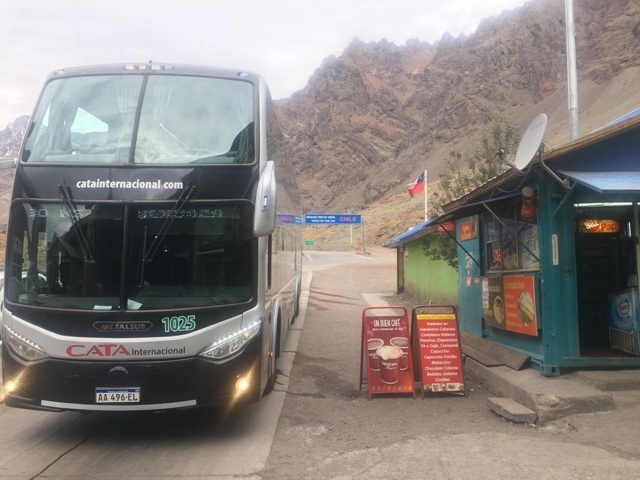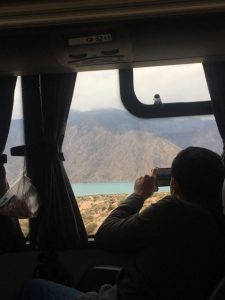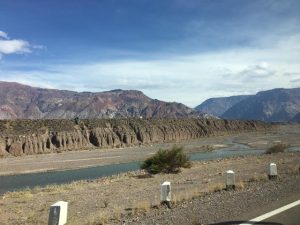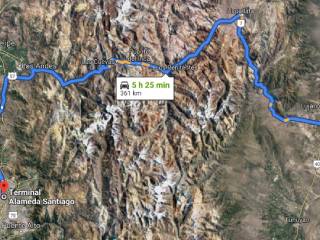If you are thinking about visiting Santiago, Chile from Mendoza, Argentina, or vice-versa, you may be exploring a few different travel options depending on your budget and time. Though, don’t panic about doing an overland journey between the two countries. In fact, as the crow flies, the distance between these two cities is only about 80 miles.
Located in a relatively similar latitude as the Chilean capital, Mendoza is the most important city in the Region of Cuyo, at the heart of Argentina’s wine industry. It is due to the vast, rolling Andes mountains and glaciers that drive time nears 6-7 hours (including the immigration stop) over 224 miles.
The main options for your trip
You have a few options. Two of the most popular are:
- Flying – flight time is about 45 minutes and you will see one of the most amazing views of the mountains.
- LatAm
- Sky
- Taking the bus – bus time is about 7 hours including the stop at immigration and customs (time may vary depending on the line at the border)
Not as popular, but also considerations:
- Hiring a car to take you across the border
- Due to a last-minute airline strike resulting in cancelled flights from Mendoza, we explored this option. We were being quoted about US$600 for two people so we quickly decided to take the bus.
- Driving a personal or rented vehicle
- You will need to prepare a few items before you take your car across the border including a letter from the rental company (if rented), proof of insurance, and an international driver’s license.
For those who have the time, option number 2, taking a bus, is one of the most popular options because of the scenic route through the Andes and the affordability.
Two of the more reputable bus companies, AndesMar and CATA, offer double-decker buses. The 1st floor is considered the VIP section and is comprised of about 9, Lazy-Boy-inspired recliners equipped with a blanket, TV, and USB port. The 2nd floor contains about 50 seats, set-up more along the lines of a Greyhound bus. And yes, there is a bathroom! However, you may want to bring your own toilet paper since it is not uncommon for the bus to run out.
Crossing the border – A long but fun trip
Prices will vary depending on the Peso-to-your-currency conversion; but upon writing this, I was able to get a VIP seat for $1250 ARS + $125 ARS fee = $1375 ARS, which was about US$30. Let’s dig into how it works:
Reaching the Border
- Buy your ticket online and bring a printed copy with you. You can also buy a ticket at the bus station, but buses do have a tendency to sell out before the departure date.
- Check into the international kiosk for your respective bus line at the bus station. They will check your passport and put a stamp on your ticket. From there, they will also tell you what “parada” number the bus will be at.
- Struggling with excess luggage and without seeing any signs, I was unsure of what bus gate to go to. I ended up walking around until I found an office for the bus company I was riding with, and they explained step #2 to me.
- The handler will load your luggage and provide you with a luggage ticket.
- Hop on the bus and relax! On CATA, they provided sandwiches to each passenger before arriving at the border and then a cracker snack pack after the border check.
- Before arriving at the border, you will receive a customs form to complete.
- Once arriving at the border, you will be instructed to get into the immigration line by your bus attendant. You do not need your carry-ons at this point, but you will need to have your passport on you.

The CATA bus at the border
Going through Customs and Heading to Santiago
- Once everyone on your bus has gotten their immigration stamp, you will be directed into the customs area with all of your belongings including your carry-ons. (You can hop back on the bus to pick up your belongings). Here you will hand over your customs form to the border agents. The luggage handlers will unload the bus luggage, and everyone will wait for the luggage to pass through the x-ray. Once the luggage has cleared, each person will put their carry-on through the x-ray.
- Make sure you do not have any fruit, plants, or meat at this point as the border patrol is very strict in making sure you are not transporting insects or diseases.
- The timing for Steps 6-7 will vary depending on the traffic at the border. We were the only bus clearing immigration and customs and the process took about an hour. I imagine there could be a back-up at times so pack your patience!
- Once everyone is cleared, you’ll hop back on the bus and continue to the bus station.
- At the bus station you will have the option to call an Uber (Santiago* – refer to point 4 of the section below if you are considering an Uber), take a cab, hop on the metro (Santiago), or grab a ride with a friend.
- Here I found an ATM and took out some Chilean Pesos so I wasn’t left without any local currency.
- Pro travel tip – if you travel often and are concerned about the currency ATM fees, consider getting a Charles Schwab checking account. With the debit card, you are exempt from paying those pesky ATM fees.
There is no longer the US$160 immigration fee when passing between Chile and Argentina. So, as a US citizen, I did not have to pay anything.
What I wish someone told me beforehand
- If you are departing from Mendoza, get a seat on the right side of the bus so that you have unobstructed views of Embalse Potrerillos. This is an incredible, milky blue dam that is set against the Andes. It is a great photo opp!

Potrerillos Dam - Take small bills and coins with you. The luggage loaders at the bus station and also at immigration/customs will straight-up ask for a “propina.” While only a handful of people tip these workers, it is a nice gesture to give them a few coins.
- If you get motion sick, take Bonine beforehand. While the bus ride is mostly pleasant, after crossing into Chile you have a series of 29 curves in the shape of infinity signs to get down the mountain.
- Ubers work in Santiago! But if you want to grab an Uber, make sure you go to the right place. Although the area is unmarked, and Uber does not have any specific directions in the App, I got reprimanded by my Uber driving for requested a pick-up in a prohibited area.

I was doing this trip solo and was not too sure what to expect. However, I found the experience to be very straight-forward. The bus attendants are very helpful, so don’t be afraid to ask questions if you are unsure of what to do. Most of them will speak both English and Spanish.
Bon voyage!



